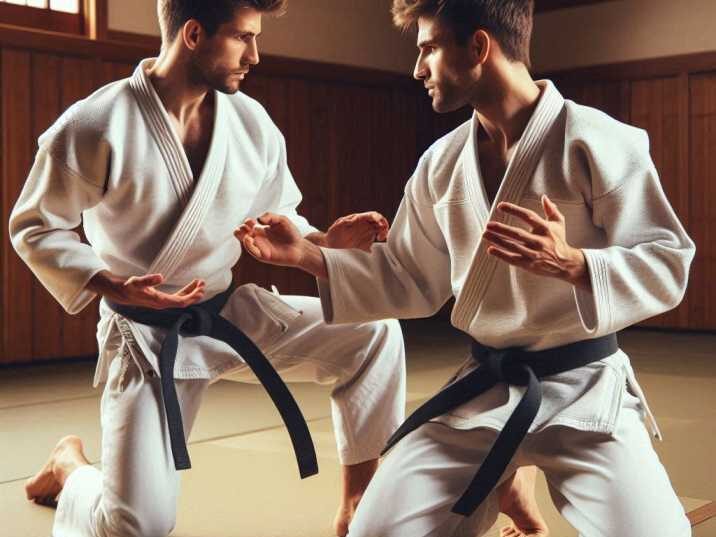Introduction
Table of Contents
Brazilian Jiu-Jitsu and Jiu-Jitsu may sound similar, but they are actually two distinct forms of martial arts with unique histories, techniques, and purposes. Both styles focus on self-defense and controlling an opponent, but they use different approaches to achieve these goals. Learning about these differences is important for anyone interested in martial arts or seeking a new way to build discipline, concentration, and confidence. Understanding how these styles differ can also help in choosing which one best matches your goals and interests.
In this article, we’ll explore the major differences between Brazilian Jiu-Jitsu and Jiu-Jitsu, from their origins to their techniques and benefits. Let’s dive into this exciting world of martial arts!

1. Origins of Brazilian Jiu-Jitsu vs. Traditional Jiu-Jitsu
Brazilian Jiu-Jitsu (BJJ)
Brazilian Jiu-Jitsu originated in the early 20th century when Japanese Jiu-Jitsu master Mitsuyo Maeda moved to Brazil and began teaching the art to locals. The Gracie family, notably Helio Gracie, transformed it into a unique fighting style, focusing on leverage and ground control rather than strength. BJJ became popular worldwide for its effectiveness in self-defense and mixed martial arts (MMA) competitions.
Traditional Jiu-Jitsu
Traditional Japanese Jiu-Jitsu has a much older history, dating back to feudal Japan where it was used by Samurai warriors. It includes various techniques such as joint locks, throws, and strikes and focuses on using an opponent’s energy against them. Traditional Jiu-Jitsu was designed primarily for battlefield scenarios, where warriors were often armed and faced life-or-death situations.
2. Fighting Style and Techniques
Brazilian Jiu-Jitsu Techniques
In Brazilian Jiu-Jitsu, the focus is on ground-fighting and grappling. BJJ practitioners learn how to bring an opponent to the ground and control them there using joint locks and chokeholds. BJJ relies heavily on techniques that allow a smaller, weaker person to control a larger, stronger opponent by using leverage and precise movements.
Traditional Jiu-Jitsu Techniques
Traditional Jiu-Jitsu includes a mix of standing techniques and some ground techniques but emphasizes strikes, throws, and joint manipulation. This style is well-rounded and often practiced with the idea of disabling an opponent quickly. Traditional Jiu-Jitsu can involve striking and blocking as well, whereas BJJ mainly avoids strikes.
3. Purpose and Application
Brazilian Jiu-Jitsu
Brazilian Jiu-Jitsu is primarily practiced for sport and self-defense. In competitions, the goal is to submit the opponent using various holds and locks. Because it emphasizes ground fighting, BJJ is very effective in self-defense situations, especially against opponents who are larger and stronger.
Traditional Jiu-Jitsu
Traditional Jiu-Jitsu, on the other hand, was designed for combat and self-protection. It includes techniques that are meant to quickly neutralize or disable an opponent, especially in situations where weapons might be involved. This makes traditional Jiu-Jitsu more combat-focused, while BJJ leans toward sport and self-defense applications.
4. Training Structure
Brazilian Jiu-Jitsu Training
In BJJ, training often starts with practicing specific techniques, followed by live sparring or “rolling.” Rolling is a core part of training, where students test their skills in a controlled environment. This structure helps practitioners develop their reflexes, control, and strategic thinking.
Traditional Jiu-Jitsu Training
Traditional Jiu-Jitsu training includes kata (structured forms or routines), drills, and partner exercises. These help students learn the basics of balance, joint locks, throws, and other techniques. Sparring may be less common, focusing instead on perfecting each move with precise form.
5. Uniform and Belt System
Brazilian Jiu-Jitsu Uniform
In Brazilian Jiu-Jitsu, practitioners wear a Gi (a lightweight jacket and pants) or train without one (No-Gi). The belt system goes from white to black, with belts awarded based on skills and achievements. BJJ belts are often harder to earn and take many years of dedicated training.
Traditional Jiu-Jitsu Uniform
Traditional Jiu-Jitsu practitioners also wear a Gi, but the uniform style and belt ranking system can vary based on the specific school or region. Japanese Jiu-Jitsu has a similar belt system but may not be as rigorous in terms of ranking progression as BJJ.
6. Mindset and Discipline
Discipline in Brazilian Jiu-Jitsu
BJJ emphasizes strategy, patience, and persistence. Practitioners learn to “play the long game,” carefully planning each move to gain control over an opponent. This type of training builds mental resilience and teaches how to handle pressure effectively.
Discipline in Traditional Jiu-Jitsu
Traditional Jiu-Jitsu places a strong focus on respect, honor, and discipline. Training in traditional Jiu-Jitsu often includes learning Japanese terminology, rituals, and philosophy. This helps students connect with the martial art’s roots and develop a disciplined mindset.
7. Physical Benefits and Self-Improvement
Brazilian Jiu-Jitsu Benefits
BJJ training involves intense physical activity that improves strength, flexibility, and stamina. Regular practice boosts cardiovascular health and promotes mental focus, which can benefit students in school and other activities.
Traditional Jiu-Jitsu Benefits
Traditional Jiu-Jitsu training also offers physical benefits but focuses more on balance, coordination, and agility. Since it involves standing techniques, it provides a well-rounded workout that improves body control and balance.
Table of Comparison
| Feature | Brazilian Jiu-Jitsu (BJJ) | Traditional Jiu-Jitsu |
|---|---|---|
| Origin | Brazil, early 20th century | Feudal Japan |
| Primary Focus | Ground fighting, grappling | Throws, strikes, joint locks |
| Purpose | Sport and self-defense | Combat and self-protection |
| Training Structure | Technique drills, live sparring (rolling) | Kata, partner drills, structured techniques |
| Uniform and Belt System | Gi or No-Gi; white to black belt | Gi; varies by school |
| Physical Benefits | Strength, flexibility, stamina | Balance, coordination, agility |
Conclusion
Brazilian Jiu-Jitsu and Traditional Jiu-Jitsu are fascinating martial arts with unique characteristics. BJJ, with its ground-based techniques, is popular in MMA and self-defense due to its practical effectiveness in real-world situations. Traditional Jiu-Jitsu, deeply rooted in Japanese history, offers a broader range of techniques including throws and strikes. Both styles build discipline, focus, and respect, making them rewarding practices for students of all ages.
Ultimately, choosing between Brazilian Jiu-Jitsu and traditional Jiu-Jitsu depends on your personal goals. Whether you’re interested in competing, self-defense, or learning martial arts for mental growth, both styles offer valuable life skills and physical benefits.
FAQs
1. What is Brazilian Jiu-Jitsu best known for?
Brazilian Jiu-Jitsu is best known for its ground fighting techniques and submissions, like chokes and joint locks.
2. How is traditional Jiu-Jitsu different from Brazilian Jiu-Jitsu?
Traditional Jiu-Jitsu includes a wider range of techniques, including strikes, throws, and joint locks, while BJJ focuses on grappling and ground control.
3. Which style is more effective for self-defense?
Both styles are effective for self-defense, but Brazilian Jiu-Jitsu may be more practical in one-on-one situations, especially if an attacker is larger.
4. Can kids learn Brazilian Jiu-Jitsu?
Yes, BJJ is suitable for kids and helps them build discipline, focus, and confidence.
5. Is there a belt ranking system in Jiu-Jitsu?
Yes, both Brazilian and traditional Jiu-Jitsu use a belt system, with rankings that reflect a student’s progress and skills.


